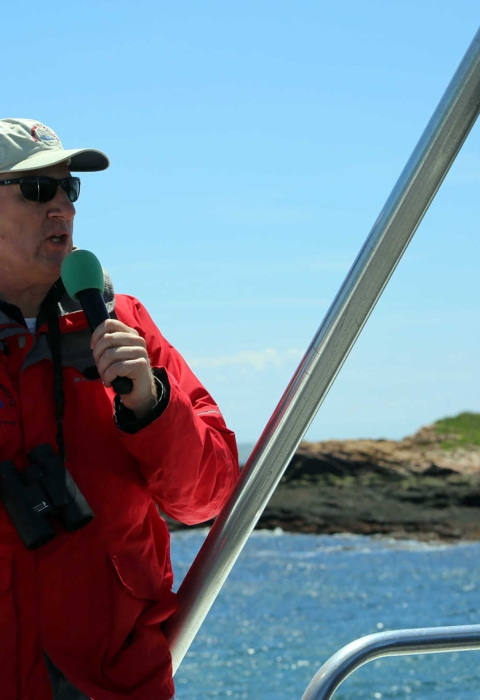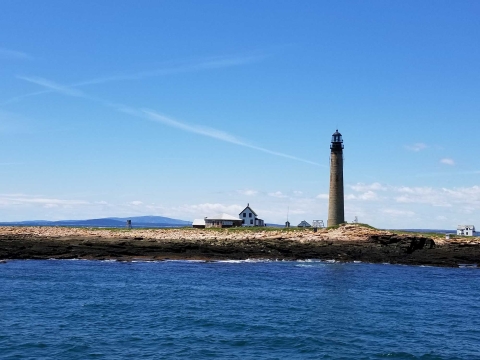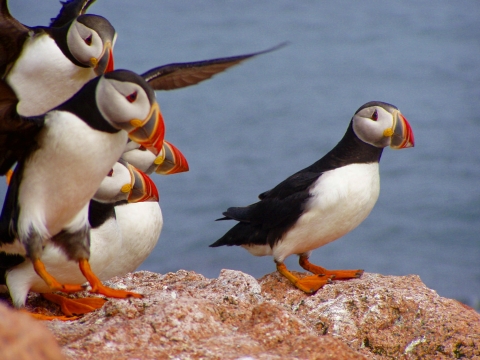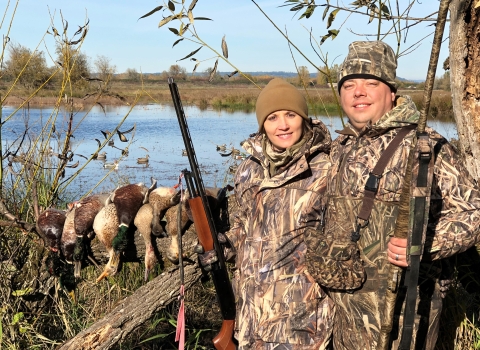Zack Klyver calls the ocean his “church.”
As chief interpreter with Bar Harbor Whale Watch Company, he worships daily during the summer, sharing his commitment to, and concern for, the sea’s most magnificent creatures, large and small.
Klyver, in his 29th season with the company, has been there from the start, when whales were the company’s only offering. The route to the offshore whale feeding grounds, however, takes them past Petit Manan Island and the seabirds that nest there.
The island is managed by the U.S. Fish and Wildlife Service (Service) as part of the Maine Coastal Islands National Wildlife Refuge Complex. It offers a rare opportunity to view Atlantic puffins. Maine is the only state in the U.S. where these “clowns of the sea” nest.
Over the years, the Service and Bar Harbor Whale Watch have developed a symbiotic relationship, with one providing the resource and scientific expertise and the other supplying the visitors and interpretation. Theirs is a case of conservation and commerce coexisting — to the benefit of all.
“Seeing an island managed for wildlife makes for a better experience and provides an opening to discuss greater marine issues,” Klyver said.
“The issues seabirds are facing are often the same as whales are facing.”
Plus, puffins are dependable.
When whales fail, puffins prevail
On a late-May day, recorded sea shanties and seabird calls filled the air as excited passengers boarded Friendship V, a 112-foot catamaran moored at the Bar Harbor town pier. A lobster boat puttered up to a nearby dock. The Margaret Todd, a four-masted schooner with salmon-colored sails, slipped between islands in the outer harbor.
Klyver, dressed in a windbreaker and khakis, climbed the stairs to the upper deck and headed for the front of the boat. Passing over the rope marked “Crew Only,” he slipped into his compact “office” — no bigger than a phone booth — and took a seat in the swivel chair. A little sunblock, a quick mic-check, and he was ready to roll.
The Friendship V’s engines rumbled as the vessel slipped away from the dock.
The route to sea took the boat through waters sprinkled with multi-colored lobster buoys. As it entered the breezy Frenchman’s Bay, people piled on warm layers or sought shelter in the cabin below.
About 30 minutes into the trip, Petit Manan Island appeared. Passengers hurried to the upper deck. Binoculars and cameras were primed as the boat drew near the 10-acre outcrop and its 119-foot lighthouse.
The island, once a U.S. Coast Guard station, is home to a seabird restoration program run by the Service. Terns took wing and circled the boat as it neared. They beat the air with their wings and called vociferously.
Every few seconds, something resembling a giant bumblebee went by.
These were the puffins.
Klyver did his best to point them out, giving locations as if the boat were a giant clock, with 12 o’clock at the bow. People moved from one side of the vessel to the other to get a better look.
“When I was a student in college,” said Klyver, “I came out here, saw one puffin, and thought it was a big deal.”
A figure appeared outside the former lighthouse keeper’s house, waving to the boat. Alex Vidal, a seabird technician who will spend the summer with the birds, had been waiting for the visitors. Klyver pulled out a two-way radio and asked Vidal to talk about his work.
Vidal described the life of an island researcher. He and his team search for and mark seabird nests, returning to band chicks to track their survival. They also record the types of fish adult birds bring to the chicks, looking for changes in the forage fish population caused by warming ocean temperatures.
After Klyver bid farewell to Vidal and told a few bad tern jokes (“What do you call a tern that changes direction? A U-tern.”), the boat eased away from the island, headed for the open ocean.
Twenty minutes later, Friendship V came to stop in the open ocean. Klyver instructed passengers to watch the horizon for spouts erupting from the waves — whale blows.
But that day, they saw none. After nearly an hour of watching and waiting, the boat headed in, offering views of Acadia National Park and lighthouses on Great Duck and Baker islands on the return to Bar Harbor.
The clowns of the sea draw crowds
In breeding plumage, puffins’ white faces, triangular eye-markings, orange bills, and bright yellow “rosettes” evoke sorrowful circus clowns in heavy makeup.
Their waddling gait and slight clumsiness on land only add to the impression.
But puffins are not easy to spy. A pelagic, or open ocean, species, they spend most of the year at sea, returning to rocky islands along the North Atlantic coast to breed and nest each summer.
Bar Harbor Whale Watch added a stop at Petit Manan Island to some of their tours in 1994, and the puffins, along with the other seabirds, are a big draw.
“On one trip, we came upon a group of whales feeding,” said Klyver. “There was lots of action, and we debated whether to skip the puffins to spend more time with the whales. We asked the passengers, and 30-to-40 percent didn’t want to miss the puffins.”
Saving the seabirds
Many of the thousands of islands along the Maine coast historically hosted thriving seabird colonies. But by the late 1800s, egg and feather collecting, along with shooting, had wiped out the birds. Protections enacted in the early 20th century helped populations rebound. They also boosted the number of herring and black-backed gulls, which outcompete and prey on other seabirds.
In 1984, the Service set out to restore the seabird colony on Petit Manan Island by controlling the numbers of herring and black-backed gulls. Common and Arctic terns quickly returned to the island, and puffins soon followed. Black guillemots, razorbills, Leach’s storm-petrels, common eiders, and laughing gulls now nest there, and federally endangered roseate terns sometimes alight there.
“The seabirds of Petit Manan Island rely on the Service’s management,” said Service biologist Linda Welch. “Without the Service, the island would be a gull colony, with no puffins or terns.”
Eighty-five percent of the Atlantic puffins in the U.S. nest on three islands managed as part of the National Wildlife Refuge System. In addition, more than 98 percent of the terns in Maine nest on islands managed by the Service or its conservation partners.
‘Conservation heroes’
With daily tours from late May through mid-August, Bar Harbor Whale Watch brings about 20,000 visitors to Petit Manan Island each year. For some, it’s their first exposure to the National Wildlife Refuge System and the Service’s work.
And some have travelled great distances for a peek at puffins and their kin. A recent tour hosted a businessman from Japan who had taken a side trip from New York City to photograph the birds.
“The only way to reach the island is by boat, and it’s closed to visitors during the seabird nesting season,” Welch said. “It’s hard to get people excited about something they can’t see, so Bar Harbor Whale Watch provides a valuable service.”
Welch leads a session on seabird ecology and conservation at the company’s annual training and has created seabird posters and brochures for the tour boats. Monitors in the main cabin of the Friendship V display high-definition video of the seabird colony.
The Friendship V, Klyver said, is also “a platform for research.” In addition to working with the Service, Bar Harbor Whale Watch partners with the College of the Atlantic and University of Maine-Orono, taking scientific observers onboard to monitor pelagic seabirds and marine mammals that feed in the Gulf of Maine.
“When you don’t have information, you make poor decisions,” said Klyver. “Scientists are conservation heroes.”
Klyver is a conservation hero of sorts himself. Under his leadership, the whale-watching company is actively engaged in the fight to save Atlantic herring. Arguably the most popular fish in the sea, it’s eaten by everything from seabirds, to marine mammals, to people.
The company is a member of CHOIR, a coalition of commercial and recreational fishing groups, conservation organizations, and ecotourism businesses. Formed in 2002, the organization worked to pass a regulation to keep highly efficient herring midwater trawlers at least 50 miles offshore to prevent the collapse of local herring populations.
“A healthy marine ecosystem drives business,” said Klyver, who has recruited other whale-watch companies to the cause. “I’ve been an observer and scientist around the world for 30 years, and it’s painful, the number of things coming at us that are affecting the oceans.”
After three decades with the same company, some folks would relish the creature comforts that come with seniority — a reserved parking space, perhaps, or maybe a corner office and executive washroom.
Not Zack Klyver. He’s happy to walk to the boat each day, pick up his mic, and speak for the sea and her creatures. It’s not work; it’s worship.






